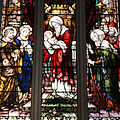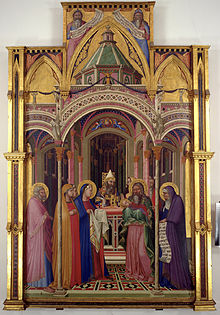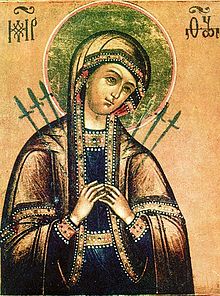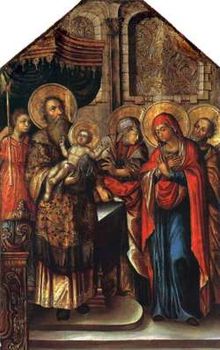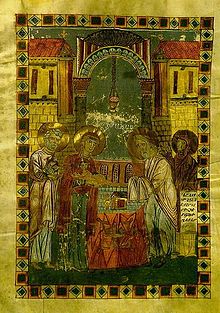- Presentation of Jesus at the Temple
-
This article is about the Christian holiday. For other uses, see Presentation of Jesus at the Temple (disambiguation).
The Presentation of Jesus at the Temple 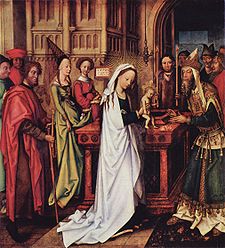
Presentation of Christ at the Temple by Hans Holbein the Elder, 1500–01 (Kunsthalle, Hamburg)Observed by Anglicans
Eastern Orthodox
Lutherans
Oriental Orthodox
Roman Catholics
MethodistsType Christian Date 2 February (Julian 2 February at present corresponds to Gregorian 15 February) The Presentation of Jesus at the Temple, which falls on 2 February, celebrates an early episode in the life of Jesus. In the Eastern Orthodox Church and some Eastern Catholic Churches, it is one of the twelve Great Feasts, and is sometimes called Hypapante (lit., 'Meeting' in Greek). Other traditional names include Candlemas, the Feast of the Purification of the Virgin, and the Meeting of the Lord. In some Western liturgical churches, Vespers (or Compline) on the Feast of the Presentation marks the end of the Epiphany season. In the Church of England, the Presentation of Christ in the Temple is a Principal Feast celebrated either on 2 February or on the Sunday between 28 January and 3 February.
In the Latin Rite of the Catholic Church, the Presentation of Jesus at the Temple is the fourth Joyful Mystery of the Rosary.
Contents
Scripture
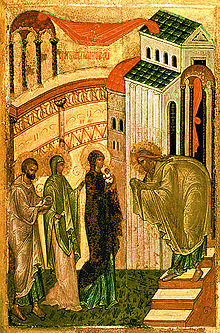 Meeting of the Lord, Russian Orthodox icon, 15th century.
Meeting of the Lord, Russian Orthodox icon, 15th century.
The event is described in the Gospel of Luke (Luke 2:22–40). According to the gospel, Mary and Joseph took the baby Jesus to the Temple in Jerusalem forty days (inclusive) after his birth to complete Mary's ritual purification after childbirth, and to perform the redemption of the firstborn, in obedience to the Law of Moses (Leviticus 12, Exodus 13:12-15, etc.). Luke explicitly says that Joseph and Mary take the option provided for poor people (those who could not afford a lamb) (Leviticus 12:8), sacrificing "a pair of turtledoves, or two young pigeons." Leviticus 12:1-4 indicates that this event should take place forty days after birth for a male child, hence the Presentation is celebrated forty days after Christmas. This ceremony is still practiced by Orthodox and Conservative Jews and is called a Pidyon HaBen.
Upon bringing Jesus into the temple, they encountered Simeon the Righteous. The Gospel records that Simeon had been promised that "he should not see death before he had seen the Lord's Christ" (Luke 2:26). Simeon prayed the prayer that would become known as the Nunc Dimittis, or Canticle of Simeon, which prophesied the redemption of the world by Jesus:
Now you are releasing your servant, Master, according to your word, in peace; for my eyes have seen your salvation, which you have prepared before the face of all peoples; a light for revelation to the nations, and the glory of your people Israel (Luke 2:29-32).
Simeon then prophesied to Mary: "Behold, this child is set for the falling and the rising of many in Israel, and for a sign which is spoken against. Yes, a sword will pierce through your own soul, that the thoughts of many hearts may be revealed" (Luke 2:34-35).
The elderly prophetess Anna was also in the Temple, and offered prayers and praise to God for Jesus, and spoke to everyone there about Jesus and his role in the redemption of Israel (Luke 2:36-38).
In art
The event forms a usual component of extensive cycles of the Life of Christ and also of the Life of the Virgin, although there is often a choice made to show only one of this and the visually similar Circumcision of Jesus. Early images concentrated on the moment of meeting with Simeon, typically shown at the entrance to the Temple, and this is continued in Byzantine art and Eastern Orthodox icons to the present day. In the West, beginning in the 8th or 9th century, a different depiction at an altar emerged, where Simeon eventually by the Late Middle Ages came to be shown wearing the elaborate vestments attributed to a Jewish high priest, and conducting a liturgical ceremony surrounded by the family and Anna. In the West Simeon is more often already holding the infant, or the moment of handover is shown; in Eastern images the Virgin is more likely still to hold Jesus.[1]
-
James Tissot - The Presentation of Jesus in the Temple (La présentation de Jésus au Temple) - Brooklyn Museum
-
Stained glass window at St. Michael's Cathedral (Toronto) depicts Infant Jesus at the Temple
Name of the celebration
In addition to being known as the Presentation of Jesus at the Temple, other traditional names include Candlemas, the Feast of the Purification of the Virgin, and the Meeting of the Lord.
In the Eastern Orthodox Church and Greek Catholic Churches (Eastern Catholic Churches which use the Byzantine rite), it is known as the "Feast of the Presentation of our Lord, God, and Savior Jesus Christ in the Temple" or as "The Meeting of Our Lord, God and Saviour Jesus Christ". In the Roman Catholic Church, it is known as the "Presentation of the Lord" in the liturgical books first issued by Paul VI,[2] and as the "Purification of the Blessed Virgin Mary" in earlier editions.
In the churches of the Anglican Communion, it is known by various names, including: The Presentation of Our Lord Jesus Christ in The Temple (Candlemas) (Episcopal Church), The Presentation of Christ in the Temple, and The Purification of the Blessed Virgin Mary (Anglican Church of Canada), The Presentation of Christ in the Temple (Candlemas) (Church of England), and The Presentation of Christ in the Temple (Anglican Church of Australia).
It is known as the Presentation of Our Lord in the Evangelical Lutheran Church in America. In some Protestant churches, the feast is known as the Naming of Jesus (though historically he would have been named on the eighth day after the Nativity, when he was circumcised).
Liturgical celebration
Traditionally, Candlemas had been the last feast day in the Christian year that was dated by reference to Christmas. Subsequent moveable feasts are calculated with reference to Easter.
Western Christianity
Candlemas occurs 40 days after Christmas.
Traditionally the Western term "Candlemas" (or Candle Mass) referred to the practice whereby a priest on 2 February blessed beeswax candles for use throughout the year, some of which were distributed to the faithful for use in the home. In Poland the feast is called Święto Matki Bożej Gromnicznej (Święto, "Holiday" + Matka Boska, "Mother of God" + Gromnica, "Thunder"). This name refers to the candles that are blessed on this day, called gromnicy, since these candles are lit during (thunder) storms and placed in windows to ward off storms.
Within the Roman Catholic Church, since the liturgical reforms of the Second Vatican Council, this feast has been referred to as the Feast of Presentation of the Lord, with references to candles and the purification of Mary de-emphasised in favor of the Prophecy of Simeon the Righteous. Pope John Paul II connected the feast day with the renewal of religious vows.
This feast never falls in Lent (the earliest Ash Wednesday can fall is February 4, for the case of Easter on March 22 in a non-leap year). However, in the Tridentine rite, it can fall in the pre-Lenten season if Easter is early enough, and "Alleluia" has to be omitted from this feast's liturgy when that happens.
According to over eight centuries of tradition, the swaddling clothes that baby Jesus wore during the presentation at the Temple are kept in Dubrovnik Cathedral, Croatia.[3]
Eastern Christianity
In the Byzantine tradition (Eastern Orthodox and Greek Catholic), the Meeting of the Lord is unique among the Great Feasts in that it combines elements of both a Great Feast of the Lord and a Great Feast of the Theotokos (Mother of God). It has a forefeast of one day, and an afterfeast of seven days. However, if the feast falls during Cheesefare Week or Great Lent, the afterfeast is either shortened or eliminated altogether.
The holy day is celebrated with an all-night vigil on the eve of the feast, and a celebration of the Divine Liturgy the next morning, at which beeswax candles are blessed. This blessing traditionally takes place after the Little Hours and before the beginning of the Divine Liturgy (though in some places it is done after). The priest reads four prayers, and then a fifth one during which all present bow their heads before God. He then censes the candles and blesses them with holy water. The candles are then distributed to the people and the Liturgy begins.
The services for the Meeting of the Lord contain hymns composed by many of the great Church hymnographers: St. Andrew, Bishop of Crete (7th cent.); St. Cosmas, Bishop of Maiuma; St. John Damascene; St. Germanus, Patriarch of Constantinople (8th cent.); and St. Joseph the Hymnographer, Archbishop of Thessalonica (9th cent.)
On the same day, Orthodox Christians also commemorate a wonder-working icon of the Theotokos known as "the Softening of Evil Hearts" or "Simeon's Prophecy." It depicts the Virgin Mary with her hands upraised in prayer, and seven swords piercing her heart. This is one of the few Orthodox icons of the Theotokos which do not depict the infant Jesus.
It is because of the biblical events recounted in the second chapter of Luke that the Churching of Women came to be practiced in both Eastern and Western Christianity. Though the usage has mostly died out in the West, the rite is still practiced in the Eastern Orthodox Church.
Some Christians observe the practice of leaving Christmas decorations up until Candlemas.
Date
In the Eastern and Western liturgical calendars the Presentation of the Lord falls on 2 February, forty days (inclusive) after Christmas. In the Church of England it may be celebrated on this day, or on the Sunday between 28 January and 3 February.
The date of Candlemas is established by the date set for the Nativity of Jesus, for it comes forty days afterwards. Under Mosaic law as found in the Torah, a mother who had given birth to a man-child was considered unclean for seven days; moreover she was to remain for three and thirty days "in the blood of her purification." Candlemas therefore corresponds to the day on which Mary, according to Jewish law, should have attended a ceremony of ritual purification (Leviticus 12:2-8). The Gospel of Luke 2:22–39 relates that Mary was purified according to the religious law, followed by Jesus' presentation in the Jerusalem temple, and this explains the formal names given to the festival, as well as its falling 40 days after the Nativity.
In the Armenian Apostolic Church, the Feast, called "The Coming of the Son of God into the Temple" (Tiarn'ndaraj, from Tyarn-, "the Lord", and -undarach "going forward"), is celebrated on 14 February. The Armenians do not celebrate the Nativity on 25 December, but on 6 January, and thus their date of the feast is 40 days after that: 14 February. The night before the feast, Armenians traditionally light candles during an evening church service, carrying the flame out into the darkness (symbolically bringing light into the void) and either take it home to light lamps or light a bonfire in the church courtyard.
History
The Feast of the Presentation is among the most ancient feasts of the Christian Church. There are sermons on the Feast by the bishops Methodius of Patara († 312), Cyril of Jerusalem († 360), Gregory the Theologian († 389), Amphilochius of Iconium († 394), Gregory of Nyssa († 400), and John Chrysostom († 407).
The earliest reference to specific liturgical rites surrounding the feast are by the intrepid nun Egeria, during her pilgrimage to the Holy Land (381–384). She reported that 14 February was a day solemnly kept in Jerusalem with a procession to Constantine I's Basilica of the Resurrection, with a homily preached on Luke 2:22 (which makes the occasion perfectly clear), and a Divine Liturgy. This so-called Itinerarium Peregrinatio ("Pilgrimage Itinerary") of Egeria does not, however, offer a specific name for the Feast. The date of 14 February indicates that in Jerusalem at that time, Christ's birth was celebrated on 6 January, Epiphany. Egeria writes for her beloved fellow nuns at home:
XXVI. "The fortieth day after the Epiphany is undoubtedly celebrated here with the very highest honor, for on that day there is a procession, in which all take part, in the Anastasis, and all things are done in their order with the greatest joy, just as at Easter. All the priests, and after them the bishop, preach, always taking for their subject that part of the Gospel where Joseph and Mary brought the Lord into the Temple on the fortieth day, and Symeon and Anna the prophetess, the daughter of Phanuel, saw him, treating of the words which they spake when they saw the Lord, and of that offering which his parents made. And when everything that is customary has been done in order, the sacrament is celebrated, and the dismissal takes place."
Originally, the feast was a minor celebration. But then in 542 the feast was established throughout the Eastern Empire by Justinian I. In 541 a terrible plague broke out in Constantinople, killing thousands. The Emperor, in consultation with the Patriarch of Constantinople, ordered a period of fasting and prayer throughout the entire Empire. And, on the Feast of the Meeting of the Lord, arranged great processions throughout the towns and villages and a solemn prayer service (Litia) to ask for deliverance from evils, and the plague ceased. In thanksgiving, the feast was elevated to a more solemn celebration.
In Rome, the feast appears in the Gelasian Sacramentary, a manuscript collection of the seventh and eighth centuries associated with Pope Gelasius I, but with many interpolations and some forgeries. There it carries for the first time the new title of the feast of Purification of the Blessed Virgin Mary.
Late in time though it may be, Candlemas is still the most ancient of all the festivals in honor of the Virgin Mary. The date of the feast in Rome was moved forward to 2 February, since during the late fourth century the Roman feast of Christ's nativity been introduced as 25 December.
Though modern laymen picture Candlemas as an important feast throughout the Middle Ages in Europe, in fact it spread slowly in the West; it is not found in the Lectionary of Silos (650) nor in the Calendar (731–741) of Sainte-Geneviève of Paris.
The tenth century Benedictional of St. Æthelwold, bishop of Winchester, has a formula used for blessing the candles. Candlemas did become important enough to find its way into the secular calendar. It was the traditional day to remove the cattle from the hay meadows, and from the field that was to be ploughed and sown that spring. References to it are common in later medieval and early Modern literature; Shakespeare's Twelfth Night is recorded as having its first performance on Candlemas Day, 1602. It remains one of the Scottish quarter days, at which debts are paid and law courts are in session.
The Presentation is chiefly observed today in the Eastern Orthodox and Anglican traditions. In the Orthodox traditions it is the day on which believers bring beeswax candles to their local church to be blessed for use in the church or in the home.
Relation to other celebrations
The Feast of the Presentation depends on the date for Christmas: As per the passage from the Gospel of Luke (Luke 2:22-40) describing the event in the life of Jesus, the celebration of the Presentation of the Lord follows 40 days after. The blessing of candles on this day recalls Simeon's reference to the infant Jesus as the "light for revelation to the Gentiles" (Luke 2:32). From a Christian perspective, therefore, there is no independent meaningfulness to the date of the Feast of the Presentation or to the blessing of candles on that day from which the name "Candlemas" derives.
Modern Pagans believe that Candlemas is a Christianization[4][5][6] of the Gaelic festival of Imbolc, which was celebrated in pre-Christian Europe (and especially the Celtic Nations) at about the same time of year.[7][8] Imbolc is called "St. Brigid's Day" or "Brigid" in Ireland.[9] Both Brigids are associated with sacred flames, holy wells and springs, healing and smithcraft. Brigid is a virgin, yet also the patron of midwives. However, a connection with Roman (rather than Celtic or Germanic) polytheism is more plausible, since the feast was celebrated before any serious attempt to expand Christianity into non-Roman countries.
In Irish homes, there were many rituals revolve around welcoming Brigid into the home. Some of Brigid's rituals and legends later became attached to the Christian Saint Brigid, who was the Abbess of Kildare and seen by Celtic Christians as the midwife of Christ and "Mary of the Gael". In Ireland and Scotland she is the "foster mother of Jesus." The exact date of the Imbolc festival may have varied from place to place based on local tradition and regional climate. Imbolc is celebrated by modern Pagans[citation needed] on the eve of 2 February, at the astronomical midpoint, or on the full moon closest to the first spring thaw.
Some[who?] have argued that the Roman church introduced Candlemas celebrations in opposition to the Roman Pagan feast of Lupercalia.[citation needed] The Catholic Encyclopædia is definite in its rejection of this argument: "The feast was certainly not introduced by Pope Gelasius to suppress the excesses of the Lupercalia," (referencing J.P. Migne, Missale Gothicum, 691). The 1911 Encyclopædia Britannica agrees: the association with Gelasius "has led some to suppose that it was ordained by Pope Gelasius I in 492 as a counter-attraction to the pagan Lupercalia; but for this there is no warrant." Since the two festivals are both concerned with the ritual purification of women, not all historians are convinced that the connection is purely coincidental. Gelasius' certainly did write a treatise against Lupercalia, and this still exists; see Lupercalia.
Pope Innocent XII believed Candlemas was created as an alternative to Roman Paganism, as stated in a sermon on the subject:
Why do we in this feast carry candles? Because the Gentiles dedicated the month of February to the infernal gods, and as at the beginning of it Pluto stole Proserpine, and her mother Ceres sought her in the night with lighted candles, so they, at the beginning of the month, walked about the city with lighted candles. Because the holy fathers could not extirpate the custom, they ordained that Christians should carry about candles in honor of the Blessed Virgin; and thus what was done before in the honor of Ceres is now done in honor of the Blessed Virgin.[10]
In Armenia, celebrations at the Presentation have been influenced by pre-Christian customs, such as: the spreading of ashes by farmers in their fields each year to ensure a better harvest, keeping ashes on the roof of a house to keep evil spirits away, and the belief that newlywed women needed to jump over fire to purify themselves before getting pregnant. Young men will also leap over a bonfire.
The tradition of lighting a candle in each window is not the origin of the name "Candlemas", which instead refers to a blessing of candles.
Traditions and superstitions
"Down with the rosemary, and so
Down with the bays and mistletoe;
Down with the holly, ivy, all,
Wherewith ye dress'd the Christmas Hall"—Robert Herrick (1591–1674), "Ceremony upon Candlemas Eve"As the poem by Robert Herrick records, the eve of Candlemas was the day on which Christmas decorations of greenery were removed from people's homes; for traces of berries, holly and so forth will bring death among the congregation before another year is out.[11] Another tradition holds that anyone who hears funeral bells tolling on Candlemas will soon hear of the death of a close friend or relative; each toll of the bell represents a day that will pass before the unfortunate news is learned.[citation needed]
In Scotland, until a change in the law in 1991 (see Scottish term days), and in much of northern England until the 18th century, Candlemas was one of the traditional quarter days when quarterly rents were due for payment, as well as the day or term for various other business transactions, including the hiring of servants.
In the United Kingdom, good weather at Candlemas is taken to indicate severe winter weather later: "If Candlemas Day is clear and bright, / winter will have another bite. / If Candlemas Day brings cloud and rain, / winter is gone and will not come again."[12] It is also alleged to be the date that bears emerge from hibernation to inspect the weather as well as wolves, who if they choose to return to their lairs on this day is interpreted as meaning severe weather will continue for another forty days at least.[citation needed] The same is true in Italy, where it is called Candelora.
The Carmina Gadelica, a seminal collection of Scottish folklore, refers to a serpent coming out of the mound on Latha Fheill Bride, as the Scots call Candlemas. This rhyme is still used in the West Highlands and Hebrides.
- Moch maduinn Bhride, Thig an nimhir as an toll; Cha bhoin mise ris an nimhir, Cha bhoin an nimhir rium.
- (Early on Bride's morn, the serpent will come from the hollow I will not molest the serpent, nor will the serpent molest me)
- Thig an nathair as an toll, la donn Bride Ged robh tri traighean dh' an t-sneachd air leachd an lair.
- (The serpent will come from the hollow on the brown day of Bride Though there should be three feet of snow on the flat surface of the ground)
The earliest American reference to Groundhog Day can be found at the Pennsylvania Dutch Folklore Center at Franklin and Marshall College:
Last Tuesday, the 2nd, was Candlemas day, the day on which, according to the Germans, the Groundhog peeps out of his winter quarters and if he sees his shadow he pops back for another six weeks nap, but if the day be cloudy he remains out, as the weather is to be moderate.—4 February 1841 — from Morgantown, Berks County (Pennsylvania) storekeeper James Morris' diary, [1]In France, Candlemas (French: La Chandeleur) is celebrated with crêpes, which must be eaten only after eight p.m. If the cook can flip a crêpe while holding a coin in the other hand, the family is assured of prosperity throughout the coming year.
Tenerife (Spain), Is the day of the Virgin of Candelaria (Saint Patron of the Canary Islands). 2 February.
In Southern and Central Mexico, and Guatemala City, Candlemas (Spanish: Día de La Candelaria) is celebrated with tamales. Tradition indicates that on 5 January, the night before Three Kings Day (the Epiphany), whoever gets one or more of the few plastic or metal dolls (originally coins) buried within the Rosca de Reyes must pay for the tamales and throw a party on Candlemas.[citation needed] In certain regions of Mexico, this is the day in which the baby Jesus of each household is taken up from the nativity scene and dressed up in various colorful, whimsical outfits.[citation needed]
Sailors are often reluctant to set sail on Candlemas Day, believing that any voyage begun then will end in disaster — given the frequency of severe storms in February, this is not entirely without sense.[citation needed]
Other celebrations
In June 1992, the General Assembly of SYNDESMOS (the World Fellowship of Orthodox Youth, a federation of Orthodox youth movements and theological schools around the world) proposed a World Day of Orthodox Youth to be celebrated annually on 2 February, to coincide with the Feast of the Meeting of the Lord. Members were urged to implement the celebration in their local parish churches "through concrete and appropriate activities that celebrate youth as an essential part of the Church's present and not just its future." This proposal has received the blessing of the primates of all the local Orthodox Churches.[13]
See also
- Liturgical year
- Simeon the Righteous
- Anna
- Groundhog Day
- Mardi Gras in Mobile – American festival ending with Shrove Tuesday.
References
 This article incorporates text from a publication now in the public domain: Chisholm, Hugh, ed (1911). Encyclopædia Britannica (11th ed.). Cambridge University Press.
This article incorporates text from a publication now in the public domain: Chisholm, Hugh, ed (1911). Encyclopædia Britannica (11th ed.). Cambridge University Press.Notes
- ^ Schiller, 90–94
- ^ Liturgy of the Hours, 2 February.
- ^ Janekovic-Romer, Zdenka (1996) (in Croatian), Javni rituali u politickom diskursu humanistickog Dubrovnika, Zavod za hrvatsku povijest Filozofskog fakulteta Zagreb - Institute of Croatian history, Faculty of Philosophy Zagreb, p. 78, http://hrcak.srce.hr/file/76971
- ^ witchology.com Retrieved February 7, 2008
- ^ NOS GWYL FAIR (Candlemas) Page Retrieved February 7, 2008
- ^ Imbolc Customs and Lore Selena Fox, Circle Sanctuary, 1996. Retrieved February 7, 2008
- ^ Milk Symbolism in the 'Bethu Brigte' by Thomas Torma University of Ulster Center for Irish and Celtic Studies, eDIL Project. Retrieved February 7, 2008.
- ^ Brighid: What Do We Really Know? by Francince Nicholson, Celtic Well E-Journal, 1999. Retrieved February 7, 2008.
- ^ On St. Brigit and Pagan Goddesses in the Kingdom of God by Sherry Rowley, Canadian Woman Studies Vol 17,No.3 1998. Retrieved February 7, 2008.
- ^ Curiosities of Popular Customs and of rites, ceremonies, observances, and miscellaneous antiquities, by William Shepard Walsh, 1898. Pg. 168. Retrieved February 7, 2008.
- ^ Robert Chambers (1832), "Christmas decorations", The book of days, 2, W. & R. Chambers Ltd, p. 753
- ^ Old sailors sayings
- ^ "World Day Of Orthodox Youth, February 2/15". Syndesmos. http://www.syndesmos.org/content/en/events/other_events/wdoy/. Retrieved 2011-02-13.
Sources
- Schiller, Gertud, Iconography of Christian Art, Vol. I, 1971 (English trans from German), Lund Humphries, London, ISBN 853312702
Further reading
- "Candlemas" article from The Catholic Encyclopedia, F. G. Holweck
- Sketch of Egeria's record of her pilgrimage, with quoted passages
- Egeria's description of the liturgical year at Jerusalem
- Food and Feast in Medieval England, P. W. Hammond, ISBN 0-7509-0992-7
External links
- Text of Luke 2 in the New Revised Standard Version
- Traditions: Celebrating Candlemas
- Origins of Candlemas Cantica Nova
- History of the feast of the Purification/Candlemas Latin Mass Society
- Liturgical Resources—Candlemas
- The Meeting of Our Lord in the Temple from the Prologue from Ochrid by St. Nikolai Velimirovich
- Poems by Robert Herrick including "Upon Candlemas Eve"
Infant Jesus at the Temple
Life of Jesus: The NativityPreceded by
Circumcision of JesusNew Testament
EventsFollowed by
Star of BethlehemCategories:- Joyful Mysteries
- Catholic holy days
- Jesus
- Christian festivals and holy days
- Christmas-linked holidays
- February observances
- Anglicanism
- Great Feasts of the Orthodox Church
- Eastern Christian liturgy
- Holidays in Scotland
- Gospel of Luke
- Scottish quarter days
-
Wikimedia Foundation. 2010.


